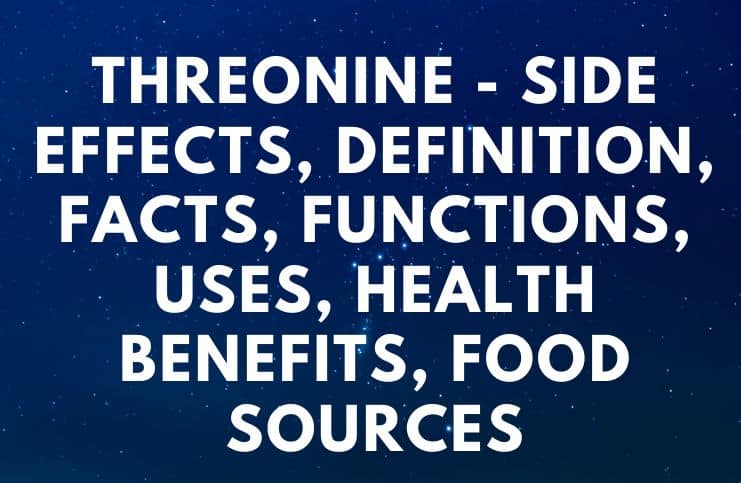Threonine – Side Effects, Definition, Facts, Functions, Uses, Health Benefits, Food Sources:
Facts
It is the last discovered amino acid, by William Cumming Rose in 1935.
Threonine is considered an essential amino acid as it is present in the central nervous system (useful in the treatment of various types of depression), in the heart, skeletal muscles.
It helps maintain a balance of proteins in the body and is important for the metabolism of bone muscle. Its chemical formula HO2CCH(NH2)CH(OH)CH3.
Uses and health benefits
Skin health
It is used to form the two most important substances for connections in the body – collagen, and elastin – thus playing an important role in maintaining healthy skin and joints.
It is also important for maintaining a proper protein balance and preventing the formation of fat in the liver. More importantly, this essential amino acid is considered helpful in building tooth enamel and strong bones.
Boosts immune system
This amino acid is involved in the liver’s functioning, lipotropic function (when combined with aspartic acid and methionine), maintenance of the immune system by stimulating the production of antibodies, and the growth and activity of the thymus.
Thymus gland
This essential amino acid is an immunostimulant that promotes the growth of the thymus gland. This endocrine gland is situated a little to the right and above the heart, behind the sternum, and in front of the trachea and aortic arch.
A healthy thymus gland is essential in allergies and autoimmune diseases where T-cell (a type of lymphocyte that has a central role in cell-mediated immunity) production needs balancing.
Depression
Anxiety disorders are the most frequent mental illness in the United States, affecting 18 percent of the population of more than 40 million adults age 18 and older. The World Health Organization also found that nearly fifty percent of people globally with depression and anxiety do not get medical care.
Interestingly, individuals with depression are 400% more likely to develop cardiovascular disease than those without these mental disorders. This amino acid works to alleviate stress as well as anxiety.
Enhances other nutrients
But perhaps the most useful property of all is that it allows better absorption of other nutrients so that protein sources containing this amino acid are more bio-available than others.
Improves your sleep
According to the CDC, more than 1/3 of United States adults usually sleep fewer than 6 hours per night.
The main causes are stress, technology, prescription medications, energy drinks, and a lack of physical exercise. According to research, this amino acid can help you get the sleep you need.
Celiac disease
Celiac disease is a long-term autoimmune disorder mainly affecting the small intestine. When people with this condition consume foods with gluten (a protein found in rye, wheat, and barley), their immune system attacks the small intestine.
The most common symptoms of this condition include – constipation, mouth ulcers, fatigue, bone or joint pain, diarrhea, cramping, unexplained weight loss, abdominal bloating, irritability, and moodiness. Consuming foods high in this amino acid reduces the symptoms of celiac disease.
Vitamin B12
It is essential in the biosynthesis of vitamin B12. Vitamin B12 benefits your energy level, mood, heart, memory, hair, skin, and digestion.
Signs of deficiency in vitamin b12 include – shortness of breath, heart palpitations, tiredness, weakness, lightheadedness, pale skin, a smooth tongue, muscle weakness, diarrhea, constipation, gas, loss of appetite, or vision loss.
Deficiency
Threonine deficiency may increase the risk of intestinal infections, a fatty liver, and the occurrence of absorption disorders of nutritional protein in the body.
Food Sources
It is an essential amino acid vital for health, which can not be synthesized by the body and, therefore, must be taken from food sources.
Main sources: red kidney beans, white beans, mung beans, adzuki beans, chickpeas, lentils, nuts, almonds, peanuts, Brazil nuts, hazelnuts, pecans, beer yeast, brussels sprouts, strawberries, rice bran, dairy products, eggs, fish, banana, mangoes, papayas, pineapple, broccoli, cabbage, potatoes, sweet potatoes, chia seeds, flaxseeds, sesame seeds, pumpkin seeds, watermelon seeds, hemp seeds, sunflower seeds, soybeans, whey, millet, oatmeal, oat bran, quinoa, amaranth, watercress, spirulina, and others.
Dosage
The standard dose of this essential amino acid is between 103 and 500 mg every day.
Side Effects of Threonine
Not enough research has been done about the safety of supplements containing this amino acid during breastfeeding and pregnancy, therefore women in these periods should better avoid them.
Overconsumption may lead to headaches, stomach upset, skin rash, nausea, and fatty liver for some individuals.
READ THIS NEXT:
Valine – Side Effects and Health Benefits
Tryptophan – Side Effects and Health Benefits
Essential & Nonessential Amino Acids
References https://journals.plos.org/plosone/article?id=10.1371/journal.pone.0069974 https://www.ncbi.nlm.nih.gov/pubmed/29901867
